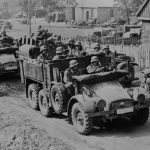
One day after the Soviet Union approved the Molotov-Ribbentrop Pact (non-aggression treaty between Germany and the Soviet Union), Germany invades Poland. On 17 September, the Soviet Union also invades and Poland is split between the two aggressors.

One day after the Soviet Union approved the Molotov-Ribbentrop Pact (non-aggression treaty between Germany and the Soviet Union), Germany invades Poland. On 17 September, the Soviet Union also invades and Poland is split between the two aggressors.
Only four cavalry/tank units are mobilized in the fall of 1939. The 1st Hussars and the Ontario Regiment (Tank) are called out to support the 1st Division. The Fort Garry Horse and the Three Rivers Regiment (Tank) will support 2nd Division.
The Canadian Armoured Fighting Vehicle School (CAFVS) at Camp Borden is also called to active service and has its name changed to Canadian Armoured Fighting Vehicle Training Centre (CAFVTC). In spite of the official changes it is still commonly referred to as the School.
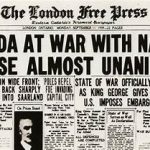
Canada declares war on Germany.
The signing of the Commonwealth Air Training Plan in December leads the government to stopping all recruiting activities except for the 1st Division. Their hope is that the air force will become Canada’s major contribution to the war. In this environment, there is even less interest in the tank.
For the same reason courses in the fall and winter for both 1st Hussars and Ontario Regiment personnel were cancelled.
A number of influential businessmen including H. L Gordon (Accountant and future Minister of Finance), J. M. MacDonnell (Lawyer and future Minister), R. S. McLaughlin (Founder of GM Canada) amongst others raised a private fund for the CAFVTC.
This fund was used to purchase radios and other wireless training equipment. Equipment for a modern kitchen such as dishwashers, peelers, beaters etc. was also procured.
GM and Ford donated not just engines and spare parts but also sent instructors and engineers to the School.
In January 1940, Lieutenant-Colonel F.F. Worthington is called to Ottawa to be told that the CAFVTC is to be closed. The army does not expect to use tanks in this war. He is to do one more course on armoured cars for the RCD and LSH and then switch to training infantry carrier drivers.
Worthington chooses to ignore the orders. He does not disband the radio, gunnery, or tactics sections. He just includes them on the infantry carrier drivers courses for the next 400 driver candidates. He also continues to train the Ontario Regiment in tank tactics when possible.
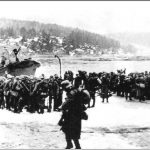
(Picture - German troops disembarking from ships in Norwegian harbour) From the first declaration of war between the Allies and Germany, no real movement has taken place on the Western Front. This quiet time is called the “Phony War” or “Sitzkrieg.” It comes to an end when Germany invades Denmark and Norway in April.
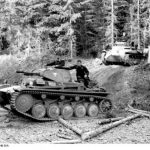
(Picture - Panzer II tank crossing into Belgium) In 1936, Belgium’s King Leopold III announced that in the event of another European war, Belgium would remain neutral. Germany accepted this in 1937. However, on 10 May 1940, the Germans invaded and Belgium fell in 18 days.
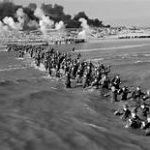
From 1-4 June 1940, more than 338,000 British and French soldiers were evacuated from Dunkirk. Many others were left to be captured along with all of their equipment.
A few days later, on 22 June, France signed an armistice and the Battle for France was over.
The Canadian Government’s reaction to Dunkirk was to restart recruiting for the 2nd Division and to authorize a third. As well, the creation of a tank brigade was under study. On 10 June 1940, the Minister of National Defence, Norman Rogers, was to fly to Toronto to meet with Worthington to discuss the organisation and training needs of a new armoured organization. Unfortunately, his plane crashed on the way and the minister was killed. His replacement, Colonel (retd) J.L. Ralston, asked Worthington to resubmit a planning paper on creating an Armoured Corps. On 19 June, Worthington resubmitted his paper, along with recommendations for training and organisation.
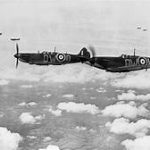
In June 1940, Germany had secured most of continental Europe and its attention turned to England.
German plans indicated a desire to blockade England and gain a negotiated peace or if necessary; invade. Either option required neutralization of the Royal Air Force.
This led to the Battle of Britain and then the Blitz.
By October 1940, it was evident that the Luftwaffe had not achieved it objectives. Britain lost a total of 1,494 aircrew from all commands while the Luftwaffe aircrew losses were counted at 2,662.
Under General Order 250, the creation of the Canadian Armoured Corps was authorized under the command of Colonel Worthington.
Initially, four units were allocated to the Corps: Fort Garry Horse, 1st Canadian Calvary Regiment (Mechanized), Ontario Regiment (Tank), and Three Rivers Regiment (Tank). Seven reserve units were also named: 2nd Fort Garry Horse, Argyll Light Infantry (Tank), 2nd Ontario Regiment (Tank), 2nd Three Rivers Regiment (Tank), Calgary Regiment (Tank), New Brunswick Regiment (Tank), and Essex Regiment (Tank). The 1st Canadian Armour Brigade was also authorised comprised of the Fort Garrys, Ontarios and TRR with the 1st Cavalry Regiment (Mechanised) attached until a second brigade could be raised
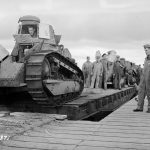
(Picture: Camp Borden Rail head; October 1940) Although Canada now had a tank brigade, it still did not have any tanks. A quick solution was the acquisition of M1917 tanks from the United States. The Americans were willing to sell war material to Canada but as they were still formally neutral such sales had to be disguised. Worthington arranged for 250 First World War era M1917 tanks (licensed copies of the Renault FT tank) from Rock Island Arsenal at a cost of 240 dollars each. To hide their use, the manifest and purchase agreements described them as “Scrap Iron” and had them delivered to the “Camp Borden Iron Works” in care of “Mr. Worthington.”
Only 236 tanks were delivered. Although already obsolete, they provided the vehicle training required for the Corps until sufficient modern vehicles became available.
In mid-December of 1940, the British War Office requested that Canada provide a full armoured division as soon as possible. Britain needed nine armoured divisions and requested that Canada supply one.
Britain will supply US-sourced M3 Tanks and training once the division is on the ground in the UK. The British plan is to have the division in England by fall of 1941 and trained for battle by summer 1942
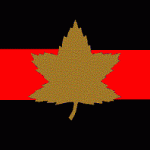
(Picture: 1 Canadian Army Tank Brigade vehicle formation sign)
1Canadian Army Tank Brigade was authorized on 4 February 1941 with the 11th Army Tank Battalion (The Ontario Regiment (Tank)) and the 12th Army Tank Battalion (The Three Rivers Regiment (Tank)). Brigadier Worthington was transferred from 1st Canadian Armoured Brigade to command the new brigade. The headquarters squadron was posted from the New Brunswick Regiment (Tank).
The 14th Army Tank Battalion (The Calgary Regiment (Tank)) joined in March.
The brigade was posted to Camp Borden and trained with M1917 and Canadian-made Valentine tanks before going overseas in July 1941.
On 15 February 1941, the Canadian Armoured Fighting Vehicle Training Centre was split into two different sections.
A8 Canadian Armoured Corps (Advanced) Training Centre would train soldiers for the Army Tank Brigade and reconnaissance units.
A9 Canadian Armoured Corps (Advanced) Training Centre would train soldiers for the newly created 1st Armoured Division.
Colonel E.L.M. Burns replaces Brigadier Worthington as Officer Administering, The Canadian Armoured Corps.
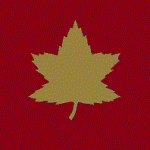
The 1st Canadian Armoured Division was composed of a headquarters squadron, an armoured car regiment and 2 brigades (each comprised of 3 tank regiments and 1 motor infantry battalion).
The formation was mobilised in February but did not reach Camp Borden for training until June.
Some traditional cavalry units are allocated to reconnaissance duties with the existing three infantry divisions.
The 4 Princess Louise Dragoon Guards serve with the 1st Canadian Division, the 14th Hussars with the 2nd, and the 17th Duke of York’s Royal Canadian Hussars with the 3rd.
These units were equipped with a mix of Universal Carriers, Humber Armoured Cars, and Humber Scout Cars.
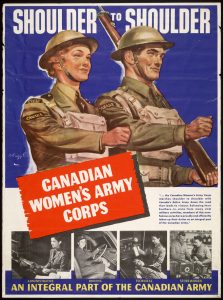
The government forms the Canadian Women's Army Corps. The first recruits begin training in September.

In a moment of clarity, the government decides that all divisions should be numbered in sequence so 1st Canadian Armoured Division becomes 5th Canadian (Armoured) Division.
The division trains in Canada and embarks for England in late November 1941.
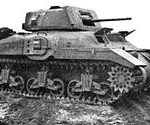
The first Canadian Ram Cruiser tank comes off the production line at the Montreal Locomotive Works' Canadian Tank Arsenal. One is shipped to England for testing, and another to the Aberdeen Proving Ground in the USA for evaluation. Mass Production starts immediately.
The first Ram Tanks reach Camp Borden in February 1942 for training purposes.
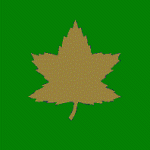
The 4th Division, which was raised as an infantry formation, was
re-designated 4th Canadian Armoured Division (4 CAD) effective 26 January 1942. The Division was quartered in Debert Nova Scotia.
As the units and soldiers of the 4 CAD had no armoured training the entire division had to under basic instruction. Since it was not feasible to move the division to Borden cadres of instructors from each unit were sent to Borden for training. They then returned to Debert to train the units. It was hoped that the training would be complete by June 1942.
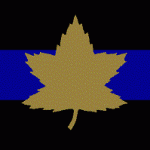
Raised on the same date as 4 CAD, 26 January 1942, the 2nd Army Tank Brigade (16/22nd Saskatchewan Horse, Halifax Rifles and Grey and Simcoe Foresters) was equipped with Ram II tanks and was able to train at the newly opened Meaford tank ranges in Ontario. This brigade was the first Canadian tank formation to have tanks at its inception.
The formation embarked for England arriving in June 1943.
In early March 1942, Major-General Worthington arrived in Debert Nova Scotia to take command of 4 CAD. While passing through Halifax he came across 165 new Mark II Ram tanks sitting at the dock awaiting shipment to Britain. The tanks were all missing their 6-pounder main armament. Worthy immediately contacted Ottawa and got them to agree to give 4 CAD 65 of the vehicles. When the 65 tanks arrived at Debert the only two people who knew how to drive a tank were Worthy and his senior staff officer, Lieutenant-Colonel Gaisford. The two senior officers thus had the task of unloading the tank train, much to the amusement of the troops.
Later a tank train carrying Rams equiped with the 6-pounder guns stopped at Debert on its way to Halifax, Worthy arranged to take four of them so that he could do gunnery training. One of them was named Robin in honour of his daughter.
Worthington and his staff were able to convert the infantry division to a capable armoured division in less than five months
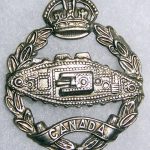
By 1942, the training facilities at Camp Borden were being overwhelmed. In May, an instructor’s course was established so that Corps training could be ramped up across the country.
In January 1942, A27 Canadian Armoured Corps Training Centre moved to Camp Dundurn in Saskatchewan.
By July 1942, the Corps Training Group included The Tactical School, The Instructors School, The Experimental Wing, The Armoured Fighting Vehicle Range and Detail, Two demonstration troops, and the Armoured Fighting Vehicle Training Centre.
In July, a large tract of land (7,200 hectares, 18,000 acres) was acquired near Meaford Ontario (approximately 100 km west of Camp Borden). This acquisition allowed for all of the tank training to remain at Borden. Meaford Ranges were officially opened in October.

The Armoured Fighting Vehicle Training Centre is renamed A33 Canadian Armoured Corps Training Establishment.
The three Training Centres (A8, A9, A28) are absorbed and restructured as Armoured Training Regiments. Each regiment has gunnery, wireless (radio), and driver/maintenance sections and train 18 officers and 300 men per month.
At this time, the staff of the training establishment is 2,300 all ranks with a student population of around 3,000.
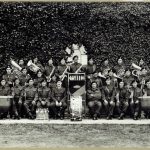
The Canadian Armoured Corps Band is formed under Bandmaster WO1 C.H. Fowke. The Band tours all of the training centres over the next year.
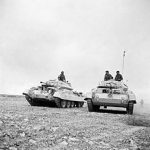
The German Army invaded France on 10 May 1940. One month later, Italy became an ally of Germany.
British, Indian, and Rhodesian forces were based in Egypt. They assumed defensive positions and the next day, began raids into Libya.
On 25 Jun 1940, the French surrendered - allowing Italian forces facing the French in Tunisia to join the Italian 10th Army. The Italian 10th Army was ordered to invade Egypt by 8 August 1940.
In May of 1944, Maj-General Worthington returns to Camp Borden as Camp Commandant; a post the he holds until retirement. Although not officially, he also commands A33 CACTC and continues to oversee the future of the Corps.
By 1943, 26,000 Canadians are serving in the Canadian Armoured Corps. On strength are four reconnaissance regiments, two armoured car regiments, two armoured divisions and two independent tank brigades.
Sources:

Canadian Armoured Fighting Vehicle School at Borden
When called to active service in 1939, CAFVS had a total manning of 39.
The Commander (Lr-Col F.F. Worthington) received unofficial aid from a small group of gentlemen who called themselves the Armoured Force Association. They included W. Lockhart Gordon (future Ministry of Finance) and R.S. (Sam) McLaughlin (Founder of GM Canada in Oshawa).
These men funded the acquisition of not just radios and other equipment from the US. They also arranged for School instructors to go for private instruction at the automobile factories under the car companies best mechanics. They also funded the Borden mess with electric devices such as dishwashers and peelers.

Tank Gunnery Simulator
RYPA (Roll, Yaw, Pitch, Alteration of course) was a tank gunnery simulator.
Students could fire an air-rifle at targets on a sand pit to simulate firing a tank gun. They sat in a skeleton simulated turret that would move to simulate cross country travel. They would look through telescopic sights to find the target, whilst using hand wheels to rotate the turret. Replica pill boxes in the sand would light up simulating the flashes of machine guns firing at the tank. A pulley system would move the board up and down and pull small tank targets across the sand.

CAFVTC Cap Badge
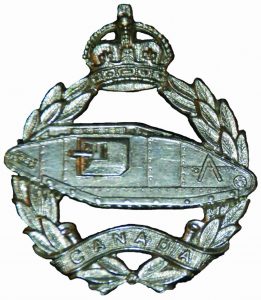 In the fall of 1939, Lt Col Worthington approached Ottawa to authorize a distinctive cap badge for the CAFVS. This was the second time as he applied a year earlier and the request was refused. This time, he was successful. The badge is based on the Royal Tank Regiment badge - a First World War tank surrounded by leaves topped by a crown and a scroll with the RTR motto "Fear Naught". The scroll's motto was replaces by the word "Canada".
In the fall of 1939, Lt Col Worthington approached Ottawa to authorize a distinctive cap badge for the CAFVS. This was the second time as he applied a year earlier and the request was refused. This time, he was successful. The badge is based on the Royal Tank Regiment badge - a First World War tank surrounded by leaves topped by a crown and a scroll with the RTR motto "Fear Naught". The scroll's motto was replaces by the word "Canada".
Although not official, it became the de facto Corps cap badge throughout the second World War.

Canadian Motorcycle Regiments in 1940
On 14 July 1940, five motorcycle regiments were formed from existing Cavalry units. This was seen as a cheaper alternative to creating Armoured Car units.
Units were issued Harley Davidson motorcycles, many with side cars.
1st, 3rd, and 4th CMR were to serve as reconnaissance with 3rd Canadian Division while 2nd and 5th took up security duties.
The units did not last long.

US Neutrality and Lend Lease
For the first two years of the Second World War, the United States remained in a state of neutrality.
This policy was announced in Chicago in a 1937 speech by President Franklin D. Roosevelt.
Although fully supportive of the Allied war effort, support had to be clandestine in nature until the passing of the Lend Lease Act on 11 March 1941.
This act provided the gift or sale of food, oil, war materials, and weapons to Allied countries. In return, military bases were leased to the US in Allied countries.
Canada has smaller acts known as the Billion Dollar Gift Act and the Mutual Aid Act.
The USA joined the war on the Axis powers in 1941 after the attack on Pearl Harbor.

US M1917 tank
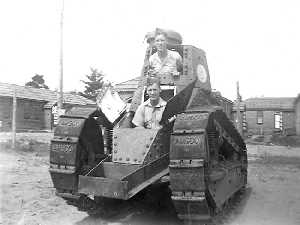 The M1917 tank was a US tank manufactured under license from Renault. It was a near-copy of the very successful WW1 Renault FT tank.
The M1917 tank was a US tank manufactured under license from Renault. It was a near-copy of the very successful WW1 Renault FT tank.
The FT was a two man crew tank with a driver and a commander/gunner. Armed with a machine gun, it was the first tank with an operational 360 degree rotating turret.
It was built out of riveted plate and its 42 HP 4-cylinder could push it along at a blistering 5.5 mph (9 kmh).
The tanks were armed with either a .30 calibre Browning machine gun or a short 37mm cannon. The tanks were sent to Canada without armament.

Canadian Armoured Corps in February 1941

1 CATB Supporting Units
1 CATB was supported by

The Canadian Ram Tank
After Dunkirk, England lost the majority of its tanks. Local English manufacturing was focused on aircraft for the Battle of Britain so new tanks would have to be built in the US.
If Canada was to have tanks, they would have to build them in Canada.
The only factory with capacity was the Canadian Pacific Railway's Angus Shops in Montreal. They started by completing 300 English Valentine infantry tanks – at the end, they produced over 1,400 Valentines, most of which went to the Soviet Union. Canada needed a faster Cruiser style tank. In September 1940, the Canadian Joint Committee on Tank Development decided to build a tank from a US standard based on the US M3 Medium tank lower hull with a new cast top hull and turret. The turret would take a 6-pounder gun.
The new hull was cast rather than welded or riveted and lower than that of the M3. The pilot model's turret and upper hull casting was produced in the US by General Steel Castings and later they aided the set up of Canadian production. Montreal Locomotive Works (MLW) was chosen to make the new Canadian M3 Cruiser Tank (as it was then known) and was given the funding to set up the Canadian Tank Arsenal at Longue Pointe. MLW was a subsidiary of the American Locomotive Company, which had experience in producing large castings and another ALCO subsidiary was producing cast hulls for the M3 Medium.
Early production Ram tanks used the 2-pounder gun due to lack of supplies. They also had right hand drive (for UK roads), side escape doors on the hull, and a sub turret with a machine gun in the left front hull. Later models did away with the side doors and sub-turret.
From February 1942 until July 1943, the Ram Mark II was in production with a 6-pounder. By the time production was completed, 1,948 vehicles plus 84 artillery observation post (OP) vehicles had been built.
The Ram Tank was used for crew training in Great Britain up to mid 1944 but never saw direct combat although its variants (observation post, Armoured Personnel Carrier, gun tractor, flame thrower, and munitions carrier) did see service in Europe.
In 1945 the Royal Netherlands Army got permission from the Canadian government to take free possession of all Ram tanks in army dumps on Dutch territory.

Canadian Women's Army Corps
Prior to the CWAC's inception, the only female role in the military was as a nurse or nursing sister in the Royal Canadian Army Medical Corps and 3,633 did serve in that capacity.
The Canadian Women’s Army Corps served alongside the Royal Canadian Air Force (Women's Division), the Women’s Royal Canadian Naval Service, and the nursing services associated with all three forces.
Between 350 and 430 women were sent for month-long basic training at Kitchener, Ontario, or Vermilion, Alberta, on a four-week course. Officers, mainly university graduates, were trained for eight weeks at Ste-Anne-de-Bellevue, Québec. Some recruits were assigned to additional specialized training for up to six months.
Almost 90 per cent of the jobs Army women performed were traditional female occupations such as cleaning or working as office personnel, as dental and medical technicians, or as telephone operators. Some women in the CWAC also worked in signalling, vehicle maintenance, ciphering and decoding.
The first draft of CWAC arrived in England on 5 November 1942. In all, nearly 3,000 members of the CWAC served overseas in England, Italy, and Europe.
At the time of the conclusion of hostilities in Europe in May, 1945,the strength of the Canadian Women’s Army Corps was 652 officers and 13,282 other ranks. Of these, 101 officers and 1843 other ranks were overseas in the European zone. There were 55 trade categories open to them.
The CWAC was disbanded on 30 September 1946

5th Canadian (Armoured) Division
5th Canadian (Armoured) Division was composed of:
Headquarters Squadron (6th Duke of Connaught's Royal Canadian Hussars)
1st Armoured Car Regiment (Royal Canadian Dragoons
1st Armoured Brigade
2nd Armoured Brigade

Supporting Units
1st Field Squadron, Royal Canadian Engineers
Support Group

4th Canadian (Armoured) Division
4th CAD was composed of:
4th (Armoured) Division Headquarters Squadron
18th (Manitoba) Armoured Car Regiment
3rd Armoured Brigade
4th Armoured Brigade

Supporting Units
Headquarters, 4th (Armoured) Divisional Support Group
Headquarters, 8th Light Anti-Aircraft Regiment, R.C.A.
3rd Anti-Tank Battery, R.C.A.
4th (Armoured) Divisional Signals, R.C.C.S.

2nd Canadian Army Tank Brigade Units
One unit that initially started with the 2nd CATB was 24th Army Tank Battalion (Les Voltigeurs de Québec) but they were reroled as a reconnaissance unit for service in Canada.
The brigade was originally composed of the following units:
Headquarters, 2nd Canadian Army Tank Brigade
20th Army Tank Battalion (16th/22nd Saskatchewan Horse)
23rd Army Tank Battalion (Halifax Rifles)
26th Army Tank Battalion (Grey and Simcoe Foresters)

Camp Debert
The spring of 1940 brought about a large number of Canadian Army units going through Halifax to England. This required an increase in staging facilities for training and marshalling combat units before embarkation.
Existing base facilities at Camp Aldershot near Kentville, Nova Scotia and Camp Sussex near Sussex, New Brunswick were upgraded to handle the requirements of housing and training brigade-size units. In 1940, additional land in Debert was acquired for a division-size training and marshalling facility adjacent to lands purchased in 1938 for a RCAF aerodrome. Debert was considered ideal as it was a flat plain with railroad access and was only 100 km north of Halifax.
On August 9, 1940, the 6th Field Company Canadian Engineers arrived at the site and began work on the Debert Military Camp. The engineers cleared the trees before building streets, sewer and water services, electricity, and buildings over an area of 80 km2 (31 sq mi).
Camp Debert was the final staging area for Canadian units going to Europe. Component units arrived at Camp Debert and were organized into larger formations before being carried by trains to troopships at Halifax, usually at night in black-out conditions.
Camp Debert was used in the repatriation of troops returning from war before being decommissioned.

Canadian Armoured Training Establishements
Canadian Tank School (London ON, 1 November 1936 - Redesignated 1 May 1938)
Canadian Armoured Fighting Vehicle School (Camp Borden, 1 May 1938 - Dormant 10 August 1940 )
Canadian Armoured Corps Training Centre (Camp Borden, Authorized 10 August 1940 - 15 Feb 1941)
A8 Canadian Armoured Training Centre (Camp Borden, Authorized 15 Feb 1941 - Amalgamated in A33 1 September 1942)
A9 Canadian Armoured Training Centre (Camp Borden, 15 Feb 1941 - Amalgamated into A33 1 September 1942)
A28 Advanced Training Centre (later re-designated A28 Cdn Armoured Corps Training Centre) (Camp Borden, 28 January 1942 - Amalgamated into A33 1 September 1942)
A33 Cdn Armoured Corps Training Establishment (Camp Borden, 1 September 1942, by the amalgamation of the three Training Centres and an existing Cdn Armoured Corps Training Group.
A13 Canadian Armoured (Basic) Training Centre – Listowel (1943)
A23 Canadian Armoured (Basic) Training Centre – Newmarket (1943-1945)
A26 Canadian Armoured (Basic) Training Centre – Orillia (1943-1944)
A27 Canadian Armoured Training Centre (Camp Borden, Authorized 28 Jan 1942 - Renamed 31 Aug 1842)
A27 Canadian Reconnaissance Training Centre (Camp Dundurn, SK, Renamed 31 August 1942 - Dormant May 1945)

Camp Dundurn
As early as 1928, the area around Dundun, Saskatchewan was used by local Militia as a training area (Dundurn Military Camp). Dundurn is located approximately 40 km south of Saskatoon.
In 1939, Camp Dundurn was the largest military base in Saskatchewan. It housed not just training camps but also acted as the transit camp for forces getting ready to go overseas. More than 50,000 soldiers from western Canada trained at Dundurn before going overseas. The base also housed a RCAF bombing range, hospital with Nurses' residence, Canadian Women's Army Corp (training and barracks), and an ammunition depot. Local Militia also trained there.
On 28 January 1942, A27 Canadian Armoured Corps Training Centre transferred from Camp Borden to Camp Dundurn. It was renamed A27 Canadian Reconnaissance Training Centre. A27 CRTC closed at the end of the war (March 1945).
Camp Dundurn continued after the war. It was a busy Cadet training area during the 1950s and 1960s, and in 1976 re-opened as a summer Militia training camp.
Camp Dundurn is now Canadian Forces Ammunition Depot Dundurn. It is the largest ammunition storage facility for the Canadian Forces. It still has a large training area including ranges and support facilities. It is used by both regular and reserve units.

Meaford Ranges
In early 1942, it was obvious that there was not enough training space at Camp Borden for extensive vehicle training. A location was needed that provided enough space for battle training, hard ground for tanks, close to railroad and highways, and the ability to support firing ranges well past 1,000 m.
A Chief Gunnery Officer named J.M. McAvity surveyed the area around Meaford and in July an offer was made to the landowners. The area included 150 farms, 4 schools, 3 churches, 2summer camps, 2 hotels, plus a number of summer cottages and hunting camps.
The acquisition plan was not well received by the land owners and the government moved to expropriate the land on 21 July 1942. All land owners had to be off of the land by 30 September.
The first delivery of 3 Ram tanks took place on 29 September. At the beginning, soldiers were billeted in the now-empty farm houses before barracks were constructed.
The official opening took place on 8 October 1943. In that year, more than 10,000 soldiers had been trained at Meaford. There were 30 tanks, ranges for rifle, tank, mortar, machine gun, and anti-tank guns, barracks, hangars and all matter of facilities. As well, 9,000 board-feet of white ash was harvested for manufacturing of Mosquito aircraft.
The Range was used up to the late 1960s when it was closed. Plans were considered to make it into a national park but this went nowhere due to the large amount of unexploded ordnance still on the ranges.
Meaford was reopened in 1989, and renamed (in 1995) Land Forces Central Area Training Centre, and later the 4th Canadian Division Training Centre.
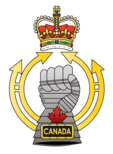
By using this site, you agree to our terms and conditions.
Terms and Conditions.
Copyright
Contact us by email.
© 2020 Royal Canadian Armoured Corps Association
